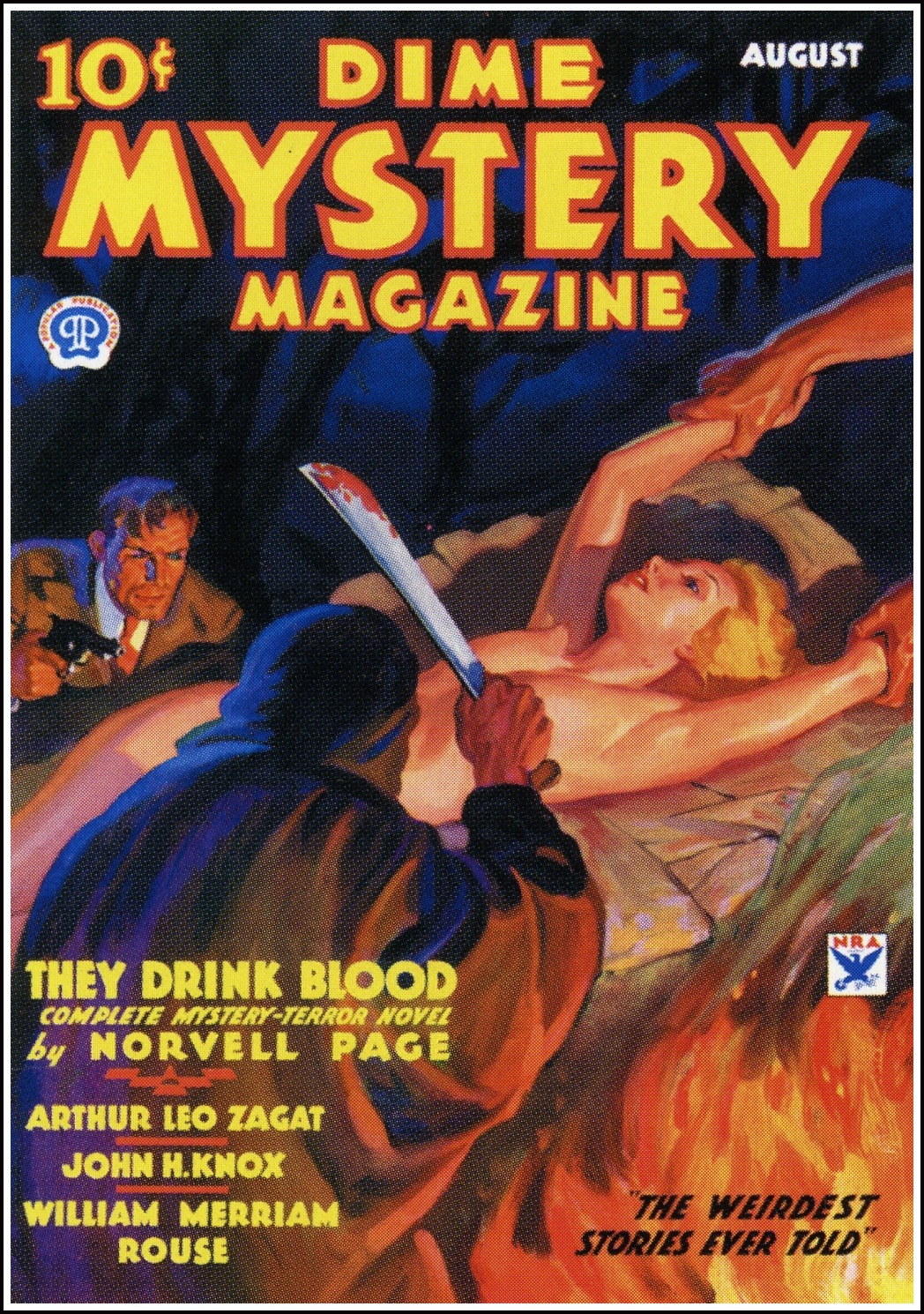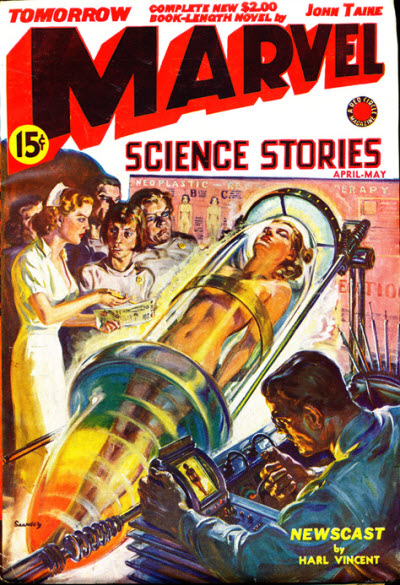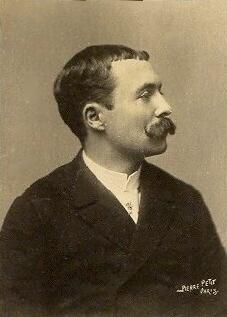|
Weird-menace
Weird menace is a subgenre of horror fiction and detective fiction that was popular in the pulp magazines of the 1930s and early 1940s. The weird menace pulps, also known as shudder pulps, generally featured stories in which the hero was pitted against sadistic villains, with graphic scenes of torture and brutality. History In the early 1930s, detective pulps like '' Detective-Dragnet'', ''All Detective'', ''Dime Detective'', and the short-lived '' Strange Detective Stories'', began to favor detective stories with weird, eerie, or menacing elements. Eventually, the two distinct genre variations branched into separate magazines; the detective magazines returned to stories predominantly featuring detection or action, while the eerie mysteries found their own home in the weird menace titles. Some magazines, for instance ''Ten Detective Aces'' (the successor to ''Detective-Dragnet''), continued to host both genre variations. Popularity and demise The first weird menace title was ... [...More Info...] [...Related Items...] OR: [Wikipedia] [Google] [Baidu] |
Marvel Science Stories
''Marvel Science Stories'' was an American pulp magazine that ran for a total of fifteen issues in two separate runs, both edited by Robert O. Erisman. The publisher for the first run was Postal Publications, and the second run was published by Western Publishing; both companies were owned by Abraham and Martin Goodman. The first issue was dated August 1938, and carried stories with more sexual content than was usual for the genre, including several stories by Henry Kuttner, under his own name and also under pseudonyms. Reaction was generally negative, with one reader referring to Kuttner's story "The Time Trap" as "trash". This was the first of several titles featuring the word "Marvel", and ''Marvel Comics'' came from the same stable in the following year. The magazine was canceled after the April 1941 issue, but when a boom in science fiction magazines began in 1950, the publishers revived it. The first issue of the new series was dated November 1950; a further six issues ap ... [...More Info...] [...Related Items...] OR: [Wikipedia] [Google] [Baidu] |
Grand Guignol
''Le Théâtre du Grand-Guignol'' (: "The Theatre of the Great Puppet")—known as the Grand Guignol–was a theatre in the Quartier Pigalle, Pigalle district of Paris (7, cité Chaptal). From its opening in 1897 until its closing in 1962, it specialised in naturalistic Horror and terror, horror shows. Its name is often used as a general term for graphic, Amorality, amoral horror entertainment, a genre popular from English Renaissance theatre, Elizabethan and Jacobean theatre (for instance Shakespeare's ''Titus Andronicus'', and Webster's ''The Duchess of Malfi'' and ''The White Devil''), to today's splatter films. Theatre ''Le Théâtre du Grand-Guignol'' was founded in 1897 by Oscar Méténier, who planned it as a space for naturalism (theatre), naturalist performance. With 293 seats, the venue was the smallest in Paris. A former chapel, the theatre's previous life was evident in the boxes – which looked like confessionals – and in the angels over the orchestra. Although th ... [...More Info...] [...Related Items...] OR: [Wikipedia] [Google] [Baidu] |
Exploitation Fiction
Exploitation fiction is a type of literature that includes novels and magazines that exploit sex, violence, drugs, or other elements meant to attract readers primarily by arousing prurient interest without being labeled as obscene or pornographic. Exploitation fiction grew out of pulp fiction of the 1930s and 1940s. It was popular "trash fiction" in the form of mass market paperbacks in the 1950s and 1960s, when genuine, sexually explicit material could be seized as obscene. In the United States, material that went by U.S. mail was subject to federal obscenity laws that greatly curtailed the distribution of materials that were sexually explicit or featured graphic violence. These cheap novels exploited violence, drugs, and sex—especially promiscuity and lesbianism—but rarely delivered the kind of salacious detail their cover art implied and generally tacked on moralistic endings to satisfy critics who accused them of having "no redeeming social value." They were often repackage ... [...More Info...] [...Related Items...] OR: [Wikipedia] [Google] [Baidu] |
Richard Von Krafft-Ebing
Richard Freiherr von Krafft-Ebing (full name Richard Fridolin Joseph Freiherr Krafft von Festenberg auf Frohnberg, genannt von Ebing; 14 August 1840 – 22 December 1902) was a German psychiatrist and author of the foundational work ''Psychopathia Sexualis'' (1886). Life Krafft-Ebing was born on 14 August 1840 in Mannheim, Germany. He studied medicine at the University of Heidelberg, where he specialized in psychiatry. He later practised in psychiatric asylums. After leaving his work in asylums, he pursued a career in psychiatry, forensics, and hypnosis. He died in Graz on 22 December 1902. He was recognised as an authority on deviant sexual behaviour and its medico-legal aspects. Principal work Krafft-Ebing's principal work is ''Psychopathia Sexualis: eine Klinisch-Forensische Studie'' (''Sexual Psychopathy: A Clinical-Forensic Study''), which was first published in 1886 and expanded in subsequent editions. The last edition from the hand of the author (the twelfth) contained ... [...More Info...] [...Related Items...] OR: [Wikipedia] [Google] [Baidu] |
The American Mercury
''The American Mercury'' was an American magazine published from 1924Staff (Dec. 31, 1923)"Bichloride of Mercury."''Time''. to 1981. It was founded as the brainchild of H. L. Mencken and drama critic George Jean Nathan. The magazine featured writing by some of the most important writers in the United States through the 1920s and 1930s. After a change in ownership in the 1940s, the magazine attracted conservative writers, including William F. Buckley. A second change in ownership in the 1950s turned the magazine into a far-right and virulently anti-Semitic publication. It was published monthly in New York City. The magazine went out of business in 1981, having spent the last 25 years of its existence in decline and controversy. History H. L. Mencken and George Jean Nathan had previously edited ''The Smart Set'' literary magazine, when not producing their own books and, in Mencken's case, regular journalism for ''The Baltimore Sun''. With their mutual book publisher Alfred A ... [...More Info...] [...Related Items...] OR: [Wikipedia] [Google] [Baidu] |
Mystery Tales
Mystery, The Mystery, Mysteries or The Mysteries may refer to: Arts, entertainment, and media Fictional characters *Mystery, a cat character in ''Emily the Strange'' Films * ''Mystery'' (2012 film), a 2012 Chinese drama film * ''Mystery'' (2014 film), a 2014 Chinese suspense thriller adventure film * ''Mystery, Alaska'' (1999), a comedy-drama film Genres * Mystery fiction, a genre of detective fiction * Mystery film, a genre in cinema Literature * ''Mysteries'' (novel) or ''Mysterie'', an 1892 existentialist novel by Knut Hamsun * ''Mystery'' (novel), a 1990 novel by American author Peter Straub *'' The Mystery'' (1907), a novel by Samuel Hopkins Adams Newspapers * ''Mystery'' (newspaper), an African American newspaper by Martin Delany Music Groups * Mystery (band), a Canadian progressive-rock band formed in 1986 Albums and EPs * ''Mystery'' (Blk Jks EP), 2009 * ''Mystery'' (Mystery EP), 1992 * ''Mystery'' (RAH Band album), 1985 * ''Mystery'' (Faye Wong album), ... [...More Info...] [...Related Items...] OR: [Wikipedia] [Google] [Baidu] |
Martin Goodman (publisher)
Martin Goodman (born Moe Goodman; January 18, 1908 – June 6, 1992)City of New York, Department of Health Certificate and Record of Birth, January 18, 1908, No. 3268, lists name as "Moe". Bell and Vassallo list his name as "Moses", citing U.S. Census records, Birth year given as 1910, Brooklyn, in Bell, Vassallo note (p. 290), "Daniels's book gets several facts bout Goodmanwrong, including Goodman's date of birth, the name of his very first pulp, and the name of his first publishing company." Birth year also appears as 1910 at Birthdate is given as January ''8'', likely a typographical error, at was an American publisher of pulp magazines, paperback books, men's adventure magazines, and comic books, launching the company that would become Marvel Comics. Biography Moe Goodman, who would later adopt the name Martin, was the oldest son of 17 recorded children of Isaac Goodman (b. 1872) and Anna Gleichenhaus (b. 1875). His parents were Jewish immigrants who had met in th ... [...More Info...] [...Related Items...] OR: [Wikipedia] [Google] [Baidu] |
Thrilling Mystery
''Thrilling Mystery'' was an American pulp magazine published from 1935 to 1944. New York publisher Standard Magazines had a stable of magazines with the "Thrilling" prefix, including '' Thrilling Detective'', '' Thrilling Love'', and ''Thrilling Adventures'', but in 1935, Popular Publications, a rival publisher, launched a weird menace pulp titled '' Thrilling Mysteries.'' Standard Magazines sued over the use of the word "Thrilling", and Popular conceded, settling out of court. ''Thrilling Mysteries'' was cancelled after a single issue, and in October 1935 Standard began ''Thrilling Mystery''. Like ''Thrilling Mysteries'' this was a terror pulp, but it contained less sex and violence than most of the genre, and as a result, in the opinion of science fiction historian Mike Ashley, "the stories had greater originality, although they are not necessarily of better quality". Ashley singles out Carl Jacobi's "Satan's Kite", about a family cursed because of a theft from a temple in B ... [...More Info...] [...Related Items...] OR: [Wikipedia] [Google] [Baidu] |
Horror Stories (magazine)
''Horror Stories'' was an American pulp magazine that published tales of the supernatural, horror, and macabre. The first issue was published in January 1935, three years after the weird menace genre had begun with '' Dime Mystery Magazine''. ''Horror Stories'' was a sister magazine to '' Terror Tales'', whose first issue came out a year earlier. The title went on to become one of the major pulp magazines of the 1930s. ''Horror Stories'' was published by Popular Publications, founded by Harry Steeger and Harold Goldsmith. The magazine was issued with luridly illustrated covers featuring the theme of the damsel in distress, mostly executed by artist John Newton Howitt John is a common English name and surname: * John (given name) * John (surname) John may also refer to: New Testament Works * Gospel of John, a title often shortened to John * First Epistle of John, often shortened to 1 John * Second ... (1885-1958). Only one original cover painting has survived. ... [...More Info...] [...Related Items...] OR: [Wikipedia] [Google] [Baidu] |
Terror Tales
''Terror Tales'' was the name of two United States, American publications: a pulp magazine of the weird menace genre of the 1930s, and a horror comic in the 1960s and 1970s. Pulp magazine ''Terror Tales'' was originally published by Popular Publications. The first issue was published in September 1934 One of the most successful horror magazines, it was joined shortly afterwards (1935) with its sister horror pulp, ''Horror Stories (magazine), Horror Stories'', also from the same publisher. Some of the writers whose work appeared in ''Terror Tales'' included E. Hoffmann Price, Wayne Rogers, Wyatt Rainey Blassingame, Wyatt Blassingame (who later wrote nonfiction books for children), Ray Cummings, Paul Ernst (American writer), Paul Ernst, Arthur Leo Zagat and Arthur J. Burks.''Who's Who in Horror and Fantasy Fiction'', Michael Ashley, Taplinger Pub. Co., 1978. . page 234. Rudolph Belarski provided several covers for the magazine. ''Terror Tales'' ceased publication in March 1941. Ho ... [...More Info...] [...Related Items...] OR: [Wikipedia] [Google] [Baidu] |
Popular Publications
Popular Publications was one of the largest publishers of pulp magazines during its existence, at one point publishing 42 different titles per month. Company titles included detective fiction, detective, adventure novel, adventure, Romance novel, romance, and Western fiction. They were also known for the several 'weird menace' titles. They also published several pulp hero or character pulps. History The company was formed in 1930 by Harry Steeger, Henry "Harry" Steeger. It was the time of the Great Depression, and Steeger had just read ''The Hound of the Baskervilles''. Steeger realized that people wanted escapist fiction, allowing them to forget the difficulties of daily life. Steeger wrote "I realised that a great deal of money could be made with that kind of material. It was not long before I was at it, inventing one pulp magazine after another, until my firm had originated over 300 of them." In the late 1930s Steeger was under pressure to lower his rate of pay to below ... [...More Info...] [...Related Items...] OR: [Wikipedia] [Google] [Baidu] |
Dime Mystery Magazine August 1934
Dime or Dimes may refer to: Coins * Dime (United States coin) * Dime (Canadian coin) Acronyms (DIME) * Dark Internet Mail Environment * Dense inert metal explosive * Detroit Institute of Music Education ** DIME Denver, a branch of the Detroit Institute of Music Education * DIME (Diplomacy, Information, Military, and Economic) — concept of instruments of national power * Direct Internet Message Encapsulation * Distributed Internet Measurements & Simulations, DIMES * Dropping In Microgravity Environment * Dual Independent Map Encoding Banks * Dime Community Bank, in Brooklyn, New York * Dime Bank Building, Scranton, Pennsylvania * Dime Savings and Trust Company, a historic bank building in Allenstown, Pennsylvania * Dime Savings Bank (other), various banks Music * The Dimes, an American musical group * ''Dime'' (album), an album by Guardian * "Dime" (Beth song) * "Dime" (Ivy Queen song) * "Dime" (Pitbull song), a song by Pitbull featuring Ken-Y * "Dime", a ... [...More Info...] [...Related Items...] OR: [Wikipedia] [Google] [Baidu] |






